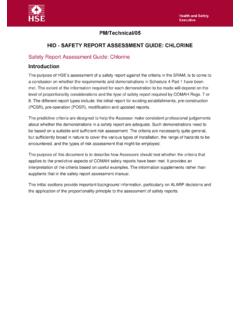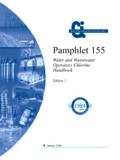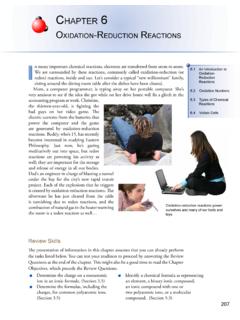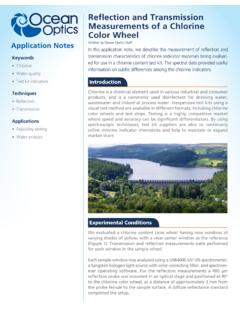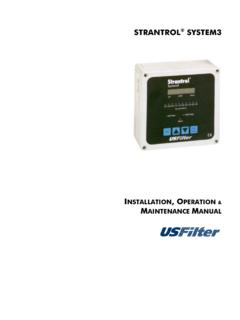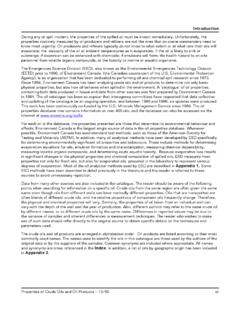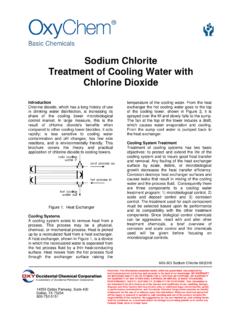Transcription of INTRODUCTION - NCP Chlorchem South Africa
1 INTRODUCTION Caustic soda lye is an almost colourless liquid. It is a strong alkali and is highly corrosive. The production of caustic soda has progressed from the LeBlanc process in 1791 to the Solvay method in 1861 and finally to the current membrane cell electrolytic process as utilized by Chloorkop. This process involves passing a salt (sodium chloride) solution through an electrolytic cell. The sodium and chlorine are electrolytically separated forming caustic soda solution, chlorine gas and hydrogen gas. The above products are produced in a specific ratio which when added together equal an electrochemical Unit (ECU). The processes used in the chlor alkali electrolysis are distinguished by the method of production. Three methods of producing caustic soda lye as utilized today, namely: Mercury cells (flowing mercury cathode) Diaphragm cells (asbestos diaphragm to separate caustic lye, hydrogen and brine) Membrane cells (ion exchange membrane to separate caustic lye and hydrogen from chlorine and brine).
2 Chlor alkali production via mercury cells has the major disadvantage in that mercury is toxic, and is present not only in gaseous and liquid emissions, but also in the caustic soda lye produced. With the technology available today it is unlikely that any new mercury type chlor alkali plants will be built. The diaphragm cell process also has a disadvantage in that the fibres within asbestos lead to handling and disposal problems (asbestosis). Diaphragm caustic soda contains 1,14% Sodium Chloride. Historically, alkalis were used for soap making and ceramic glazing, uses have now been expanded to include neutralisation of acids, hydrolysis, condensation, saponification, alumina production and as an aid in the pulp and paper industry to separate cellulose fibres from lignin. Many customers use caustic soda lye in preference to solid forms because delivery can be made in bulk, handling costs are therefore low and no dissolving equipment is required.
3 Commercial caustic soda lye is marketed at strength of around 47% with a nominal specific gravity of 1,50. The composition of this liquor is very close to an eutectic (lowest freezing point) mixture, and transport and storage difficulties due to freezing in cold weather are minimised. This publication offers advice on systems, equipment and safety procedures to enable caustic soda to be handled safely and with confidence. Storage installations should be designed to suit individual requirements. Guidance is given on the most important items, but NCP Chlorchem welcomes the opportunity to discuss a customer s needs in detail at an early stage. In accordance with the policy of the transporter, Tanker Services, all bulk installations must be inspected prior to the first delivery into the installation. the inspection is to confirm that essential requirements are present.
4 The suitability and safety of the installation is primarily the responsibility of the customer. Should you be contemplating modifying a system, or installing a new one we will be happy to provide advice and assistance. Page 1 of 28 TRADITIONAL USES AND CONSUMPTION OF CAUSTIC SODA Regeneration of anion exchange resins Acid neutralisation Manufacture of sodium salts Petroleum refining Rayon manufacture Rubber reclamation Manufacture of plastics Manufacture of soaps and detergents Pulp and paper industry Dyes and pharmaceutical industries Aluminium processing FORMS OF CAUSTIC SODA NCP Chlorchem produces and markets two forms of caustic soda: Page 2 of 28 MANUFACTURING PROCESS An electrolytic process as can be seen in the flow diagram below produces caustic soda commercially. Brine, prepared from sodium chloride (NaCl), is electrolyzed in a membrane cell.
5 The co-produced products are chlorine and hydrogen. A solution of approximately 30% NaOH in strength is produced. The solution is then send to the evaporators, which concentrate it to strength of 47% by removing the appropriate amount of water. The resulting caustic soda is quality approved and stored in storage tanks at Chloorkop. Caustic soda flake is produced through further concentration of the 47% caustic soda. Production flowchart: Membrane cell 30% Liquid caustic soda Evaporators 47% Liquid caustic soda Concentrator Bulk storage Flaker Electricity Caustic soda flakes Brine treatment NaCl + H20 = Brine Chlorine Hydrogen Page 3 of 28 Product Identification Technical Name and Description: Sodium Hydroxide (Membrane Grade) Trade Name: Sodium Hydroxide (Solution or anhydrous) Chemical Family: Alkali Hydroxide Chemical Name: Sodium Hydroxide Synonyms: Caustic Soda Lye Caustic Soda Liquid Caustic Selling Specification Membrane Cell Caustic Soda Solution (MBC) 1.
6 PRODUCT CHARACTERISTICS Colourless, viscous, slightly cloudy liquid. 2. SPECIFICATION CRITERIA UNITS/TEMP. ACCEPTANCE LIMITS Sodium Hydroxide as NaOH % m/m 47,0 min Specific Gravity at 20 C 1,50 min Chloride as Cl-% m/m 0,03 max Iron as Fe % m/m 0,001 max Sulphate as CO42-% m/m 0,01 max Carbonate as CO32-% m/m 0,20 max Product Packaging Caustic Soda Lye: Bulk road tankers: Minimum quantity per delivery = 10 ton (as 47% minimum available NaOH) Maximum quantity per delivery = 30 ton (as 47% minimum available NaOH) Caustic Soda Flakes: Road deliveries: Minimum quantity delivery per delivery = 10 ton Maximum quantity delivery per delivery = 32 ton Should delivery quantities less than the above-specified tonnage be required, please do not hesitate to contact our distributor. Delivery of Caustic Soda Lye Road tanker makes deliveries of caustic soda lye.
7 The tanker operator normally supervises discharge of product from road tankers. Customers should carefully consider the way that caustic will be received at their facility. Personnel should be prepared to deal with abnormal situations. Page 4 of 28 Unloading equipment: 1. All road tankers are fitted with transfer pumps. 2. The maximum head is 10 m. 3. Heights greater than 10 m: the customer must provide a discharge pump. Each vehicle is equipped with 5 m of 50 cm bore flexible hose with a standard flange. Page 5 of 28 CAUSTIC SODA LYE FLANGE Page 6 of 28 Driver s instructions for discharge of road deliveries A typical set of instructions to the driver for discharge by transfer pump, is indicated below. In the interest of safety it is strongly advised that customers ensure that their employees follow these recommendations. 1.
8 On arrival the driver will report to the customer s appointed responsible person. 2. The customer s responsible person will indicate the filling point at which the discharge is required. 3. The driver will position his vehicle safely and apply the hand brake. If the vehicle is on a slope, chocks must be used. 4. The driver will connect the flexible hose to the filling point. These are flange-to-flange connections, all eight bolts and rubber gasket most be used. 5. The customer s responsible person will sign the delivery note in the space provided to confirm that: a) The receiving installation is in order and can take the quantity to be delivered. b) The tanker is connected to the correct inlet valve. c) The receiving inlet valve is open and the consignment may now be discharged. d) There are no inflammable vapours within the discharge area.
9 The customer s responsible person must be available continuously during the discharge. We would recommend that the customer s responsible person wear full protective clothing, but that as a minimum requirement the representative concerned must wear goggles and rubber gloves during the discharge and subsequent operations. The driver will wear full protective clothing with which he is provided (full face protection, rubber gloves, jacket, trousers and rubber boots). As a safety precaution it is advisable that at all times during off-loading, water is running from a water hose adjacent to the unloading point. 6. The driver will open both outlet valve and the non-return valve on the tanker and start the pump. If the caustic lye does not discharge the pump must be shut-off and the outlet valves closed before taking action.
10 7. At the end of the discharge the transfer pump must be switched off. 8. The driver will close the tanker s outlet and non-return valve and the drain valve on the unloading point and the customer s responsible person will close the inlet valve. 9. The driver will place a suitable container provided by the customer beneath the drain valve on the unloading point, and by opening this valve and raising the flexible hose, drain any caustic soda lye remaining into the container. The customer s responsible person will then dispose of the drainings in a responsible manner. 10. The driver will close the tanker s outlet and non-return valve and the drain valve on the unloading point and the customer s representative will close the inlet valve. 11. The driver will then disconnect the flexible hose, replace the stoppers in the hose and returning it to its housing on the tanker and securing it.


